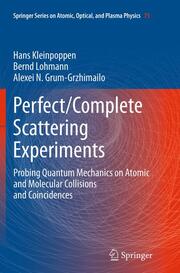Detailansicht
Perfect/Complete Scattering Experiments
Probing Quantum Mechanics on Atomic and Molecular Collisions and Coincidences, Springer Series on Atomic, Optical, and Plasma Physics 75
ISBN/EAN: 9783662500798
Umbreit-Nr.: 9701110
Sprache:
Englisch
Umfang: xiii, 340 S., 171 s/w Illustr., 6 farbige Illustr.
Format in cm:
Einband:
kartoniertes Buch
Erschienen am 23.08.2016
Auflage: 1/2013
- Zusatztext
- The main goal of this book is to elucidate what kind of experiment must be performed in order to determine the full set of independent parameters which can be extracted and calculated from theory, where electrons, photons, atoms, ions, molecules, or molecular ions may serve as the interacting constituents of matter. The feasibility of such perfect' and-or `complete' experiments, providing the complete quantum mechanical knowledge of the process, is associated with the enormous potential of modern research techniques, both, in experiment and theory. It is even difficult to overestimate the role of theory in setting of the complete experiment, starting with the fact that an experiment can be complete only within a certain theoretical framework, and ending with the direct prescription of what, and in what conditions should be measured to make the experiment `complete'. The language of the related theory is the language of quantum mechanical amplitudes and their relative phases. This book captures the spirit of research in the direction of the complete experiment in atomic and molecular physics, considering some of the basic quantum processes: scattering, Auger decay and photo-ionization. It includes a description of the experimental methods used to realize, step by step, the complete experiment up to the level of the amplitudes and phases. The corresponding arsenal includes, beyond determining the total cross section, the observation of angle and spin resolved quantities, photon polarization and correlation parameters, measurements applying coincidence techniques, preparing initially polarized targets, and even more sophisticated methods. The `complete' experiment is, until today, hardly to perform. Therefore, much attention is paid to the results of state-of-the-art experiments providing detailed information on the process, and their comparison to the related theoretical approaches, just to mention relativistic multi-configurational Dirac-Fock, convergent close-coupling, Breit-Pauli R-matrix, or relativistic distorted wave approaches, as well as Green's operator methods. This book has been written in honor of Herbert Walther and his major contribution to the field but even to stimulate advanced Bachelor and Master students by demonstrating that obviously nowadays atomic and molecular scattering physics yields and gives a much exciting appreciation for further advancing the field.
- Kurztext
- The main goal of this book is to elucidate what kind of experiment must be performed in order to determine the full set of independent parameters which can be extracted and calculated from theory, where electrons, photons, atoms, ions, molecules, or molecular ions may serve as the interacting constituents of matter. The feasibility of such perfect' and-or `complete' experiments, providing the complete quantum mechanical knowledge of the process, is associated with the enormous potential of modern research techniques, both, in experiment and theory. It is even difficult to overestimate the role of theory in setting of the complete experiment, starting with the fact that an experiment can be complete only within a certain theoretical framework, and ending with the direct prescription of what, and in what conditions should be measured to make the experiment `complete'. The language of the related theory is the language of quantum mechanical amplitudes and their relative phases. This book captures the spirit of research in the direction of the complete experiment in atomic and molecular physics, considering some of the basic quantum processes: scattering, Auger decay and photo-ionization. It includes a description of the experimental methods used to realize, step by step, the complete experiment up to the level of the amplitudes and phases. The corresponding arsenal includes, beyond determining the total cross section, the observation of angle and spin resolved quantities, photon polarization and correlation parameters, measurements applying coincidence techniques, preparing initially polarized targets, and even more sophisticated methods. The `complete' experiment is, until today, hardly to perform. Therefore, much attention is paid to the results of state-of-the-art experiments providing detailed information on the process, and their comparison to the related theoretical approaches, just to mention relativistic multi-configurational Dirac-Fock, convergent close-coupling, Breit-Pauli R-matrix, or relativistic distorted wave approaches, as well as Green's operator methods. This book has been written in honor of Herbert Walther and his major contribution to the field but even to stimulate advanced Bachelor and Master students by demonstrating that obviously nowadays atomic and molecular scattering physics yields and gives a much exciting appreciation for further advancing the field.
- Autorenportrait
- All four authors are well-known experts in various subfields of theoretical and experimental atomic and/or molecular collision physics.
